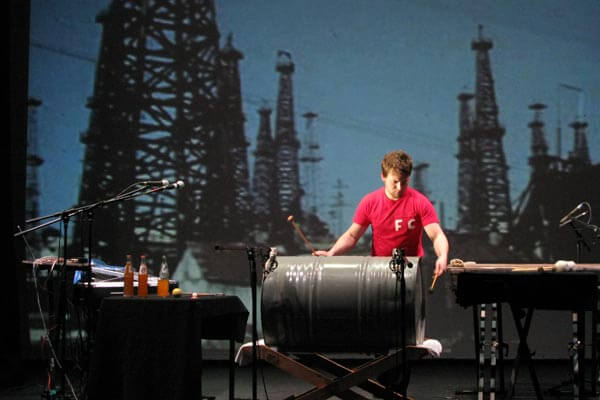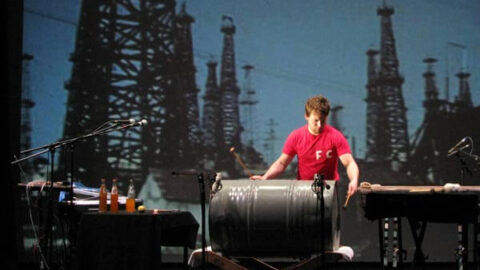 Powerplant, a trio of percussion, live visuals and sound design, commissioned a new piece from Goldfrapp’s Will Gregory. So new it was yet to be titled, they performed it on Gregory’s home turf in the stunning acoustic of St George’s Bristol on May 22, 2014. Works by Reich and Nancarrow acted as the ‘classics’ to contextualise the newer voices of Gregory, Gabriel Prokofiev, Max de Wardener and Powerplant’s own Matthew Fairclough.
Powerplant, a trio of percussion, live visuals and sound design, commissioned a new piece from Goldfrapp’s Will Gregory. So new it was yet to be titled, they performed it on Gregory’s home turf in the stunning acoustic of St George’s Bristol on May 22, 2014. Works by Reich and Nancarrow acted as the ‘classics’ to contextualise the newer voices of Gregory, Gabriel Prokofiev, Max de Wardener and Powerplant’s own Matthew Fairclough.
I first heard Will Gregory’s concert music at this venue before he had established an international reputation with Goldfrapp. It was an energetic, accomplished saxophone ensemble piece. This commission, again heard in the city in which he was born, was an assured return to classical composition with the harmonic richness and freedom that this context can provide. It also had the quirkiness, the technological finesse, and ear for timbre and colour that characterise his music across different genres. The handling of a large (19-minute) structure was the one aspect that didn’t convince.

Powerplant is a collaborative trio of percussionist Joby Burgess, sound designer Matthew Fairclough and visual artist Kathy Hinde. All three were convincing in their own right. Burgess is a charismatic virtuoso who can make a humble woodblock sing. Fairclough’s digital processing and his balancing of electronic and live sound was exemplary, exploiting the clear acoustic at St George’s Bristol. Hinde’s video work was thoughtful and classy. The true combination of all three was powerful, but only achieved sporadically.
Nancarrow’s Piece for Tape was a bracing opener, with rows of horses on screen like Muybridge’s Zoopraxiscope, triggered by woodblock ‘hooves’. Next, a new version of Reich’s My Name Is replaced spliced tape technology with computer processing. Burgess wandered around the hall gathering audio samples from the audience. The resulting piece had some of those spiritually satisfying moments that Reich’s music delivers; the piece ended as “My name is Pete” slowly emerged from a beseeching “Please, Please, Please…” There were times when I yearned for the analogue charm of tape rather than the familiar grain of digital layering. Also, Reich’s original method of collecting the recordings before the show begins, then surprising the audience with their own voices, would have been more theatrical.
I saw Burgess perform Gabriel Prokofiev’s Import/Export a few years ago and the piece still has a freshness and vibrancy. The opening oil drum sections are sonically rich and the most effective musically. The visuals acted like an abstracted documentary, showing the stories and memories of the ‘junk’ objects being played. It is sometimes unclear whether the piece is a critique of or homage to global industry, and perhaps the better for that. At times, the theatre of Burgess’s performance didn’t need the extra layer of video, and, much as I always relish an extended plastic bag cadenza, this section lost momentum and musical clarity. The most effective audio-visual moment was the manically smiling 1960’s Fanta advertising juxtaposed with the plaintive bird-like calls blown across the open Fanta bottle.
Fairclough’s The Boom and The Bap was dark and intense, deconstructing a drum break to create a rich, snarling piece for kit and live electronics. This was an excellent contrast to Max de Wardener’s light and airy ‘Until My Blood Is Pure’, newly arranged for vibraphone. The well-curated programme finished with the most recent piece: a new (as yet unnamed) work by Will Gregory for multi-tracked marimba. As Burgess raised his beaters, the home crowd leaned in expectantly.

Gregory’s piece was beautiful. The opening section constructed a long sweeping phrase which added pre-delayed notes like baroque ornaments. The grace-notes became a rippling expanse of marimba tremolos. Burgess said he had fallen in love with the piece. It was challenging enough to give the performance risk and intensity, but showed real understanding of the instrument and used technology lightly. The visuals for Gregory’s piece opened with delicate white circles echoing the notes of the phrase, but the visuals eventually lost out a little to the interest of watching the performer. The constant rising chromatic melody snaking across the range of the instrument was mesmerising. Gregory’s composition was process-driven, giving it a natural logic and shape. Like the Prokofiev, the structure was in distinct blocks. This gave it formal clarity, but in both works structure was the weakest element. Despite that, as the bowed marimba notes faded I felt had experienced something fascinating. Something I wanted to hear again.
The stand-out piece visually was Im Dorfe by Max de Wardener and Kathy Hinde. A brilliantly comic drama between live percussion and shots of pianos of varying tunings filmed from above. This was a perfect synthesis of video, recorded sound and live performance. Ideas were shared. Roles were fought over. A giant metronome appeared… The music built to a breathless climax with intense rhythms and 2-frame video cuts (Hinde confessed to months of painstaking editing).
There were many absorbing works in this programme at St George’s Bristol. Gregory’s new piece – once it has a title – will be an excellent addition to the percussion-with-electronics repertoire. However, de Waderner / Hinde’s Im Dorfe was the piece that succeeded most in achieving Powerplant’s aim of integrating live musical performance, sound design and visuals to produce a whole greater than the sum of its parts.
























